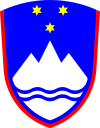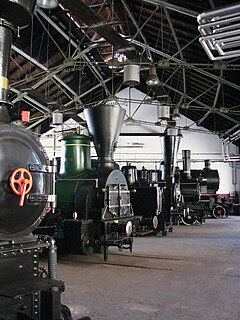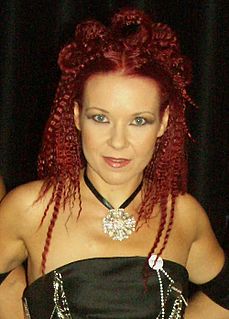 |
|---|
EU Member State |
Subdivisions of Slovenia:
 |
|---|
EU Member State |
Subdivisions of Slovenia:

Slovenia, officially the Republic of Slovenia, is a country in Central Europe. It is bordered by Italy to the west, Austria to the north, Hungary to the northeast, Croatia to the southeast, and the Adriatic Sea to the southwest. Slovenia is mostly mountainous and forested, covers 20,271 square kilometres (7,827 sq mi), and has a population of 2.1 million. Slovenes constitute over 80% of the country's population. Slovene, a South Slavic language, is the official language. Slovenia has a predominantly continental climate, with the exception of the Slovene Littoral and the Julian Alps. A sub-mediterranean climate reaches to the northern extensions of the Dinaric Alps that traverse the country in a northwest–southeast direction. The Julian Alps in the northwest have an alpine climate. Continental climate is more pronounced towards the northeastern Pannonian Plain. The capital and largest city—Ljubljana—is nearly the centre of the country.
This article refers to Telecommunications in Slovenia.
113 is the natural number following 112 and preceding 114.

The Ten-Day War, or the Slovenian War of Independence, was a brief armed conflict that followed Slovenia's declaration of independence from Yugoslavia on 25 June 1991. It was fought between the Slovenian Territorial Defence and the Yugoslav People's Army. It lasted from 27 June 1991 until 7 July 1991, when the Brioni Accords were signed.
A trunk prefix is a digit sequence to be dialed before a telephone number to initiate a telephone call for the purpose of selecting an appropriate telecommunications circuit by which the call is to be routed.
Slovenia was represented by Anžej Dežan with the song "Mr Nobody". The song is written by Urša Vlašič and composed by Matjaž Vlašič.
The Slovenian Intelligence and Security Agency is the main civilian intelligence service in the Republic of Slovenia and as a government agency is subordinated directly to the Prime Minister of Slovenia. The mission of SOVA as the central intelligence and security service in the Republic of Slovenia is to provide national security. The agency's headquarters are located at Stegne Street in Dravlje, northwest of Ljubljana's centre.

AMIS is an Internet service provider (ISP) in Slovenia, providing nationwide solutions for more than 105.000 domestic and business users with leading electronic communications and entertainment services. Company is situated in Maribor and Ljubljana. Amis was acquired by the A1 Group in 2015.

Pinoy Big Brother: Season 2 is the second main season of the Philippine ABS-CBN reality television series Pinoy Big Brother and the fourth season overall. As with the show's previous main and spin-off seasons, it also aired a companion program on Studio 23. It began with a live party on February 25, 2007. It ran for 126 days until June 30, 2007, which was the longest stay of housemates inside the house until Double Up. The season was won by Beatriz Saw, who garnered over 1.5 million votes, or about 30.29% of total votes cast during the open voting, which started on June 17, 2007. This is also the record-breaking highest total of actual votes in the history of Pinoy Big Brother and other all text-based votes reality programs in the Philippines as of now.
The use of the Internet in Slovenia is widespread. According to official polls in the first quarter of 2008, 58% of citizens between the ages 10 and 74 were internet users, which is above Europe's average. In the same period, 59% of households and 97% of companies with 10 or more employed had internet access. In 2011, 73% of households had internet access, and 67% of households had broadband. As of 2011, 29% of Slovenians had never used the internet.
Slovenia received a new country code following the breakup of the Socialist Federal Republic of Yugoslavia in 1991. Additionally, the Ipko mobile phone company in Kosovo used the +386 country code.

The Ljubljana railway station is the principal railway station in Ljubljana, the capital of Slovenia. It was completed on 18 April 1848, a year before the South railway, connecting Vienna and Trieste, reached Ljubljana. The building was renovated in 1980 by the architect Marko Mušič.

The Slovenian Railway Museum, or Railway Museum of Slovenian railways, in Ljubljana, Slovenia, located on Parmova ulica 35, is the national museum for Slovenia's railway history.

Regina is a Slovenian singer, best known for her participation in the 1996 Eurovision Song Contest.
Gibtelecom is the largest telecommunications provider in the British overseas territory of Gibraltar. Its headquarters is located on John Mackintosh Square.
Siol.net is a leading Slovenian web media, owned and managed by TSmedia company that is itself owned by the Telekom Slovenije. The main contents cover daily politics, news, sports, technology, lifestyle, and motoring. However there is a difference between SiOL branch of a company which is a cable TV, internet, and telephone provider and deals only with providing access and offering support for these services, and Siol.net, which is a news website.
The 2011 Slovenian YouTube incident was the publication of three clips of the recordings of closed sessions of the Government of Slovenia on the video-sharing website YouTube on 3 December 2011. The clips were published under the title Stari obrazi by someone who signed himself as stariobrazi (oldfaces). The publication happened during the term of the Prime Minister Borut Pahor, just before the early 2011 Slovenian parliamentary election on 4 December.
Davorin Savnik was an industrial designer and architect from Slovenia.

Duplica is a former settlement in the Municipality of Kamnik in central Slovenia. It is now part of the town of Kamnik. The area is part of the traditional region of Upper Carniola. The municipality is now included in the Central Slovenia Statistical Region.